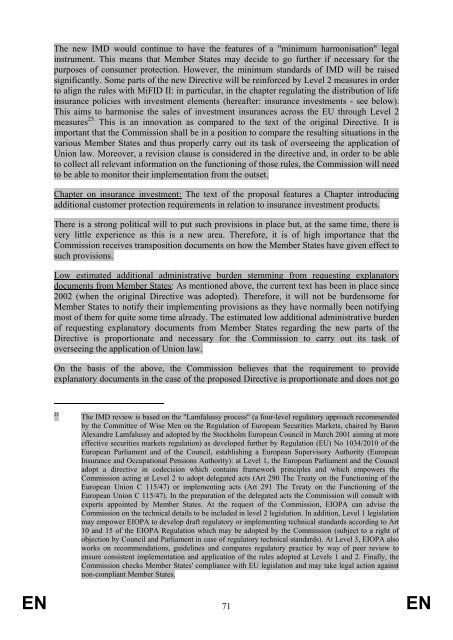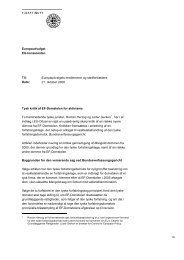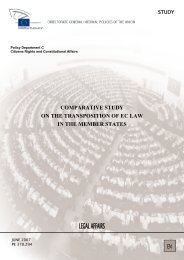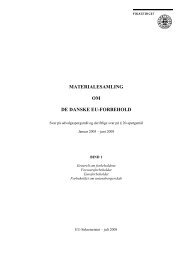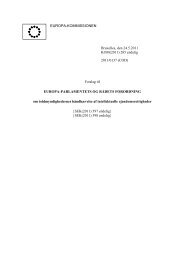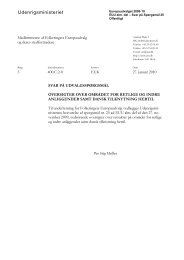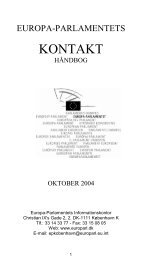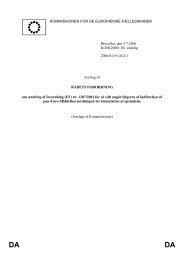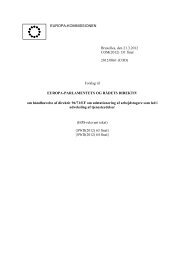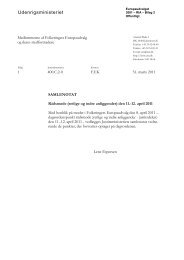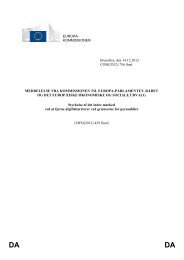EUROPEAN COMMISSION Brussels, XXX COM(2012) 360 ... - BVVM
EUROPEAN COMMISSION Brussels, XXX COM(2012) 360 ... - BVVM
EUROPEAN COMMISSION Brussels, XXX COM(2012) 360 ... - BVVM
You also want an ePaper? Increase the reach of your titles
YUMPU automatically turns print PDFs into web optimized ePapers that Google loves.
The new IMD would continue to have the features of a "minimum harmonisation" legal<br />
instrument. This means that Member States may decide to go further if necessary for the<br />
purposes of consumer protection. However, the minimum standards of IMD will be raised<br />
significantly. Some parts of the new Directive will be reinforced by Level 2 measures in order<br />
to align the rules with MiFID II: in particular, in the chapter regulating the distribution of life<br />
insurance policies with investment elements (hereafter: insurance investments - see below).<br />
This aims to harmonise the sales of investment insurances across the EU through Level 2<br />
measures 25. This is an innovation as compared to the text of the original Directive. It is<br />
important that the Commission shall be in a position to compare the resulting situations in the<br />
various Member States and thus properly carry out its task of overseeing the application of<br />
Union law. Moreover, a revision clause is considered in the directive and, in order to be able<br />
to collect all relevant information on the functioning of those rules, the Commission will need<br />
to be able to monitor their implementation from the outset.<br />
Chapter on insurance investment: The text of the proposal features a Chapter introducing<br />
additional customer protection requirements in relation to insurance investment products.<br />
There is a strong political will to put such provisions in place but, at the same time, there is<br />
very little experience as this is a new area. Therefore, it is of high importance that the<br />
Commission receives transposition documents on how the Member States have given effect to<br />
such provisions.<br />
Low estimated additional administrative burden stemming from requesting explanatory<br />
documents from Member States: As mentioned above, the current text has been in place since<br />
2002 (when the original Directive was adopted). Therefore, it will not be burdensome for<br />
Member States to notify their implementing provisions as they have normally been notifying<br />
most of them for quite some time already. The estimated low additional administrative burden<br />
of requesting explanatory documents from Member States regarding the new parts of the<br />
Directive is proportionate and necessary for the Commission to carry out its task of<br />
overseeing the application of Union law.<br />
On the basis of the above, the Commission believes that the requirement to provide<br />
explanatory documents in the case of the proposed Directive is proportionate and does not go<br />
25 The IMD review is based on the "Lamfalussy process" (a four-level regulatory approach recommended<br />
by the Committee of Wise Men on the Regulation of European Securities Markets, chaired by Baron<br />
Alexandre Lamfalussy and adopted by the Stockholm European Council in March 2001 aiming at more<br />
effective securities markets regulation) as developed further by Regulation (EU) No 1034/2010 of the<br />
European Parliament and of the Council, establishing a European Supervisory Authority (European<br />
Insurance and Occupational Pensions Authority): at Level 1, the European Parliament and the Council<br />
adopt a directive in codecision which contains framework principles and which empowers the<br />
Commission acting at Level 2 to adopt delegated acts (Art 290 The Treaty on the Functioning of the<br />
European Union C 115/47) or implementing acts (Art 291 The Treaty on the Functioning of the<br />
European Union C 115/47). In the preparation of the delegated acts the Commission will consult with<br />
experts appointed by Member States. At the request of the Commission, EIOPA can advise the<br />
Commission on the technical details to be included in level 2 legislation. In addition, Level 1 legislation<br />
may empower EIOPA to develop draft regulatory or implementing technical standards according to Art<br />
10 and 15 of the EIOPA Regulation which may be adopted by the Commission (subject to a right of<br />
objection by Council and Parliament in case of regulatory technical standards). At Level 3, EIOPA also<br />
works on recommendations, guidelines and compares regulatory practice by way of peer review to<br />
ensure consistent implementation and application of the rules adopted at Levels 1 and 2. Finally, the<br />
Commission checks Member States' compliance with EU legislation and may take legal action against<br />
non-compliant Member States.<br />
EN 71 EN


